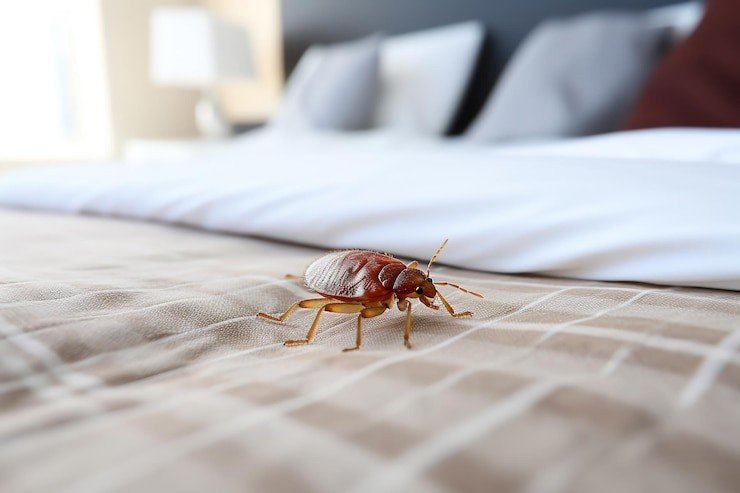How Local Experts Handle Carpenter Bee Control Without Harming Your Home
- Home
- How Local Experts Handle Carpenter Bee Control Without Harming Your Home

Carpenter bees may look harmless, but they can quietly drill into your woodwork and leave lasting damage. Unlike termites, these bees don’t eat wood—they tunnel into it to create nests. Over time, this nesting weakens wood structures and invites further pests. If ignored, you may face repairs that cost much more than a professional solution. Local experts know how to stop carpenter bees without damaging your home in the process.
Table of Contents
- What Makes Carpenter Bees a Problem?
- Signs You Have a Carpenter Bee Infestation
- Why Timing and Location Matter
- How Local Experts Tackle the Problem Safely
- Why You Shouldn’t DIY Carpenter Bee Removal
- How It Differs from Carpenter Ants Exterminator Work
- Why Choose a Pest Control Long Island New York Company
- About AM PEST SOLUTIONS
- FAQs
What Makes Carpenter Bees a Problem?
These bees don’t sting often, but their presence is far from harmless. Over time, their tunnels weaken wooden frames, decks, and siding. They come back to the same location every year.
Signs You Have a Carpenter Bee Infestation
Look out for:
- Small, round holes in wood surfaces
- Piles of sawdust near entry holes
- Buzzing sounds in wooden beams or walls
- Bees hovering near wooden decks, railings, or eaves
Why Timing and Location Matter
Spring and early summer are peak seasons. This is when carpenter bees begin building nests. If action is delayed, bees may lay eggs and expand tunnels.
The next time you spot one, take action. Early treatment can help you avoid expensive damage later.
How Local Experts Tackle the Problem Safely
Carpenter bee control services start with inspection. Local professionals check nesting sites and nearby wood structures. Then they:
- Use non-damaging treatment tools
- Apply safe dusts or sprays in the nest holes
- Seal entry points once bees are gone
- Give prevention tips for future protection
These methods avoid damage to your home’s structure. Plus, trained technicians know how to treat each home differently—because every job is unique.
Why You Shouldn’t DIY Carpenter Bee Removal
DIY sprays often miss hidden nests. Plus, most store-bought solutions offer short-term relief. If bees return, they bring friends—and more damage.
Using local carpenter bee control services ensures the nest is treated completely and professionally.
How It Differs from Carpenter Ant Control
Some people confuse carpenter ants and carpenter bees. Both damage wood but in different ways.
- Carpenter ants chew tunnels, often inside walls.
- Carpenter bees drill from the outside in.
Both need different approaches. That’s why you need a carpenter ants exterminator if ants are the issue and bee-specific treatment for bees.
Why Choose a Local Pest Control Provider
Pest Control Long Island New York companies know the local climate, common pests, and housing styles. That matters when creating a custom plan. It’s not about a one-size-fits-all fix.
When you call local professionals:
- They respond faster
- Understand the pests in your area
- Customize the solution to your home’s structure
- Treat it like it’s their own home
AM PEST SOLUTIONS: Local, Family-Oriented Pest Control
AM PEST SOLUTIONS is proud to serve Long Island and nearby areas. We’re your local pest control company. Our team uses the best products available and always brings highly trained technicians to your door.
We care for your home the same way we care for our own. That’s why Long Islanders rely on AM PEST SOLUTIONS for safe, effective carpenter bee control services.
FAQs
- How long does carpenter bee treatment take?
A standard carpenter bee treatment usually takes about one to two hours, depending on the size of the property and how many nests are present. If the infestation is larger or has spread over time, the technician may recommend a follow-up visit to make sure all bees are gone and holes are properly sealed. The sooner you act, the faster it’s resolved.
- Will carpenter bees return next year?
Yes, carpenter bees often return to the same nesting sites year after year if those entry points are not properly sealed. After removing the bees, professionals seal the holes with the right materials to prevent future nesting. Preventive treatments can also be applied in the spring to keep them from coming back when they become active again.
- Are treatments safe for pets and kids?
When performed by licensed and trained technicians, carpenter bee treatments are safe for your entire household, including pets and children. Technicians use products that are applied in targeted areas, away from common living spaces. They will also give you clear instructions on when it’s safe to return to treated areas, typically within a short time.
- Do carpenter bees eat wood?
No, carpenter bees do not eat wood like termites do. Instead, they drill into wood to create tunnels where they lay their eggs. Over time, this tunneling weakens wood structures such as decks, fences, and siding. The damage may not seem serious at first, but it can quickly grow worse if left untreated.
- How is a carpenter ants exterminator different from a bee control expert?
While both pests damage wood, carpenter ants live inside the walls and chew wood to create galleries for nesting. On the other hand, carpenter bees drill into the surface of exposed wood. Because their behaviors and nesting habits are different, professionals use different tools, products, and strategies. That’s why it’s important to hire someone who knows the difference and can apply the right solution for each.
